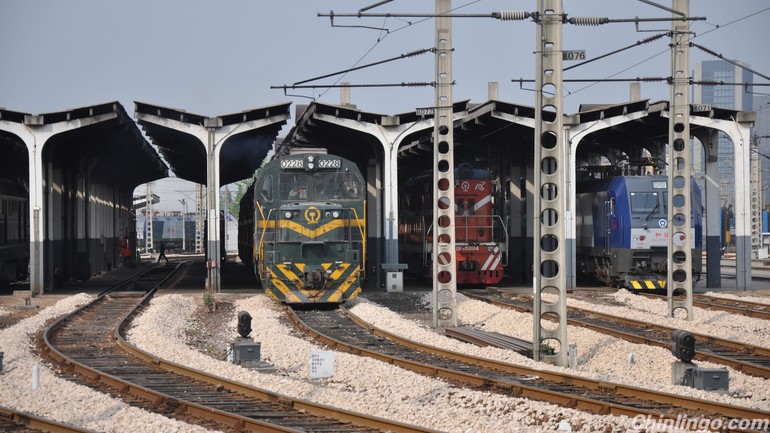
BEIJING, SEPTEMBER 1999 – Traveling by train is always interesting. In China it is a real experience. Not only the buying of the ticket is a challenge (I had the tour company doing this for me), finding out how train travel works is as exiting. Waiting in the main hall of Beijing railway station is already impressive. A lot of Chinese use the train to visit their family, or to go to school (university) or work. A lot of people still don't own a car and distances are big in this country !
北京,1999年9月 — 乘火车旅行一直是一件很有趣的事情。而在中国,那更是一次真实地体验。不仅仅买票是一次巨大的挑战(我的票是旅行公司为我买的),看火车旅行怎么进行也是一件令人兴奋的事情。在北京的火车站大厅里面等候就已经让人印象深刻了。许多中国人乘火车去看望家人,或者去学校(大学)和工作。许多人仍然没有一辆属于自己的车,距离在这个国家是十分大的。
All of the passengers are waiting in one big hall – mostly standing or sitting on the ground or on their luggage. As soon as the gate to the platform opens, everyone starts rushing through that gate. Since all places on the train are numbered, there is no need to hurry, one would think – but luggage space is limited (and some of them have a couple of chickens with them or a sack of vegetables). We just didn't care and waited till the crowd had gone through the gate to go to our train.
所有的乘客都在一个大厅里面等候—大多数站着或坐在地上或他们的行李上。只要通往月台的门一打开,每一个人就都开始使出吃奶的劲穿过那扇门。鉴于火车上的所有位子都标有数字的,所以没有必要这么着急,也许有人会这样想到—但是放行李的地方是有限的(一些人手里提着几只鸡或一袋蔬菜)。我们一点也不着急,等着直到人群都通过了那道门然后才走向了我们的列车。
As soon as we had found our carriage, we had to hand over our ticket to the guard of this carriage. He gives you a metal or plastic token and folds the ticket in such a way that it fits into his 'book'. This 'book' is his tool for knowing where everyone is going and where everyone is located on the train. In the morning he will come by some time before your stop, to return your ticket and collect the token – never loose this token, this would distress the system heavily !
一旦我们找到了我们的列车,我们就得手里拿着车票递给站在车门口的列车员查看。他会给你一块金属或者是塑料的牌子,然后他会把车票折叠好放到他的那本 “书”里面。这本“书”是他得以知道每一个人将去哪和每一个人在火车上具体的座位的工具。在早上,他会在你下车之前的一段时间里过来返还给你的车票以及回收那个牌子—千万别丢失了那个牌子,那将严重扰乱系统的运作。
On the train there are great opportunities to discover the Chinese people. As ticketing is not centralised, each railway station has some places reserved for the train. When buying a ticket, finding adjacent places is often not possible, which results in a mixture of Chinese and the odd tourists in the same compartment. Conversation is not easy, but with the help of a little phrase book, you can manage fairly ell. Usually the Chinese are very interested in looking at your guide books etc… On one of my train travels I have encountered a Chinese Civil Engineer that spoke English almost fluently. This was an ideal situation as he could be my interpreter. Another good thing is to bring a bottle of wine or spirits, to share with the Chinese, you'll make friends easily.
在火车上有很大的机会发现中国人。由于车票并不是集中的,每个火车站都保有列车的车票。当你买车票时,发现是相邻的地方经常不太可能,结果可能是中国人和 单独的外国旅行者在同一间车厢。交谈并不容易,但是在小短语书的帮助下你还是能够把握得很好的。通常中国人会对你的旅行指南等等十分有兴趣。。。记得在我 的一次旅行中,我遇到了一个能够说流利英语的中国土木工程师。当他能够成为翻译者那是最为理想的情况了。其它的有利的事情就是你带一瓶酒或者是烈酒和中国 人一起分享,那你将会很快交到朋友。
The Chinese railways have three classes of carriages : ‘soft sleeper',‘hard sleeper' and ‘hard seat'. I've traveled in the first two ones, the last mentioned is just an overcrowded carriage with wooden benches. People are everywhere, including under the benches, in the aisles, even onto the overhead luggage rack. Making your way through such a carriage is a hard job. A 'soft sleeper' compartment has soft beds, only 4 of them, and a door that you can close. The 'hard sleeper' compartment has 6 not too hard beds, but no doors at all. As a train travel can take up to 20 hours, people have brought their food to prepare & eat on the train . It can get very messy after a couple of hours (I'm deliberately not mentioning the toilets !). On each train you can also get thermos cans with hot water to make tea. They use a coal fire to boil the water. For the 'rich' traveler, there is a restaurant carriage. The food is not according to high standards here, but they really cook everything on the train ! At one occasion when sitting in the dining carriage, the kitchen seemed to be on fire … which was quickly extinguished.
中国的铁路有三种车厢:软卧,硬卧和硬座。我旅行中坐过前面两种,最后提及的一种仅仅是木制的长凳塞满了整个车厢。人无所不在,包括在椅子下,在过道中, 甚至是头顶上面的行李架上。在这样的车厢里面移动是一件困难的事情。软卧车厢有柔软地床,只有四张,和一扇你可以关闭的门。硬卧车厢则有六张很硬的床,但 是根本就没有门。由于火车旅行可能会长达20个小时,所以人们都准备了食物在火车上吃。几个小时后车厢将变得十分脏乱(我是故意没有提及厕所的!)。在每 节车厢你也可以从保温罐里面取热水泡一杯热茶。他们使用煤来烧水的。对于富裕一点的旅客来说,那里有一个餐厅车厢。食物并不是那里的高标准,但是他们真的 在火车上煮一切能煮的东西!有一次坐在餐厅车厢,厨房好像是着火了,但是很快就被扑灭了。
Another great thing about train travel in China is the stops in the railway stations. On every occasion people approach the train or even board the train to sell something, mostly food or drinks. Mostly the scenes are interesting and colorful. Sometimes the train stops in the middle of nowhere – because of some technical problem or because another train has to pass by. Then you have the kids of the country side approaching the train. Giving these children a postcard of your home country or just talking to them in English (some of them speak some English) is just plain fun ! As a tourist you are the big attraction !
另一个在中国火车旅行有趣的事情就是在火车站停靠的时候。每一次人们都接近火车甚至是上火车推销他们的东西,多数是食物和饮料。大多数这样的场景是有趣 和多姿多彩的。有时火车也会因为技术问题或者要让路而依靠在途中。给那些孩子一些你们国家的名信片或者和他们说一点英语(有些会说一点英语)那真是一件十 分快乐的事情。作为一名旅行者,你也是他人的风景!
When the train finally arrives at its destination, you get the same rush as where it all started. This time you mostly end up a square in front of the railway building, crowded with people waiting for their relatives or friends. A parking lot with buses, cars and the tourist sector people that try to sell you excursions, hotel or restaurant bookings, etc…
当火车最终到达了它的目的地时,你又会和刚开始的时候经历一番撒丫子狂奔的情形。这一次你大多会跟着在铁路建筑前面的一个广场停住,拥挤地人群等待来接他们的亲戚或者朋友们。一个停车场里面有许多公交车,汽车和旅行社的人试图向你推销旅行,宾馆或者餐饮预订等等。。。



 闽公网安备 35020302035673号
闽公网安备 35020302035673号
0 responses on "Foreigner: Travel in China by train at night in 1999"